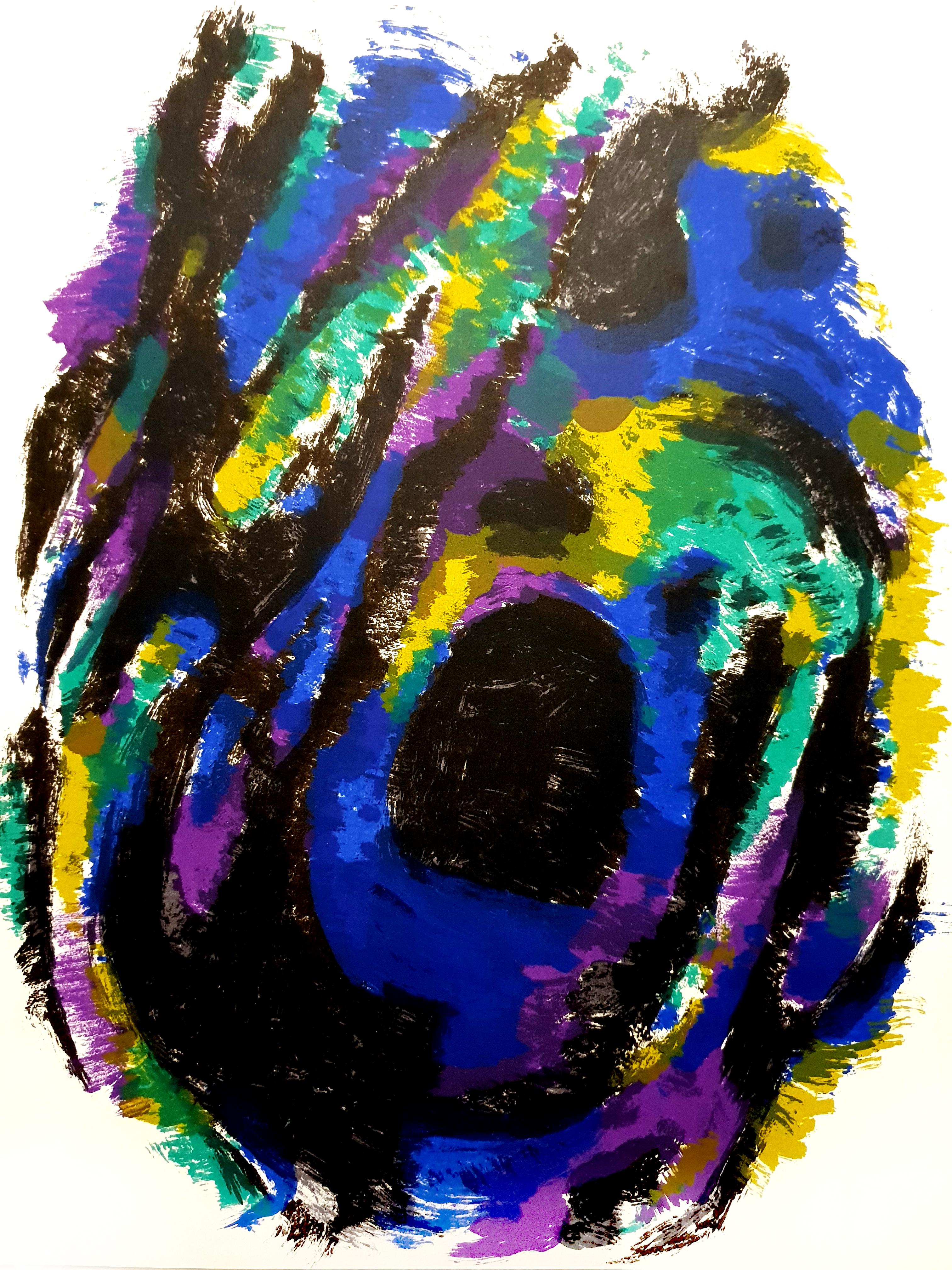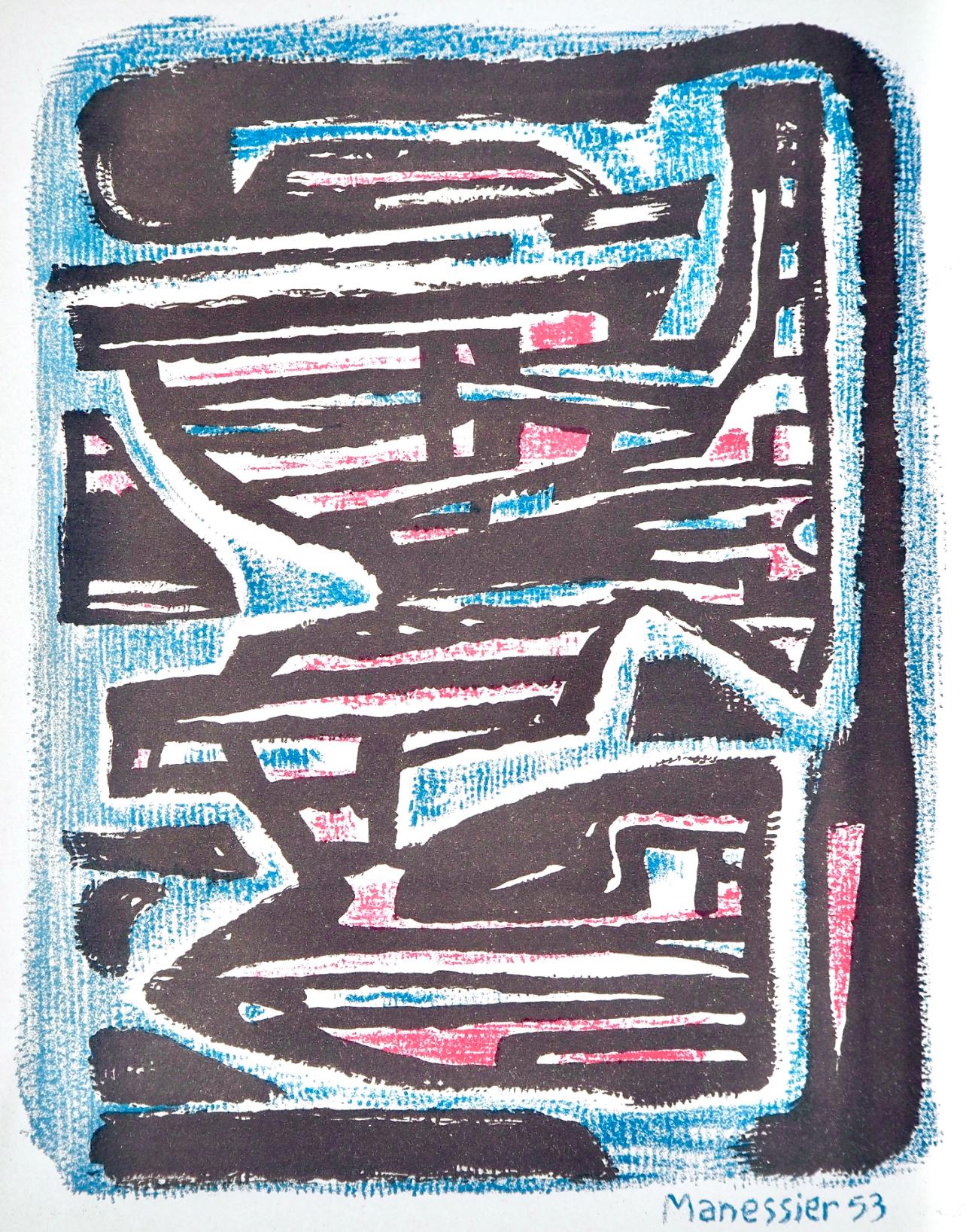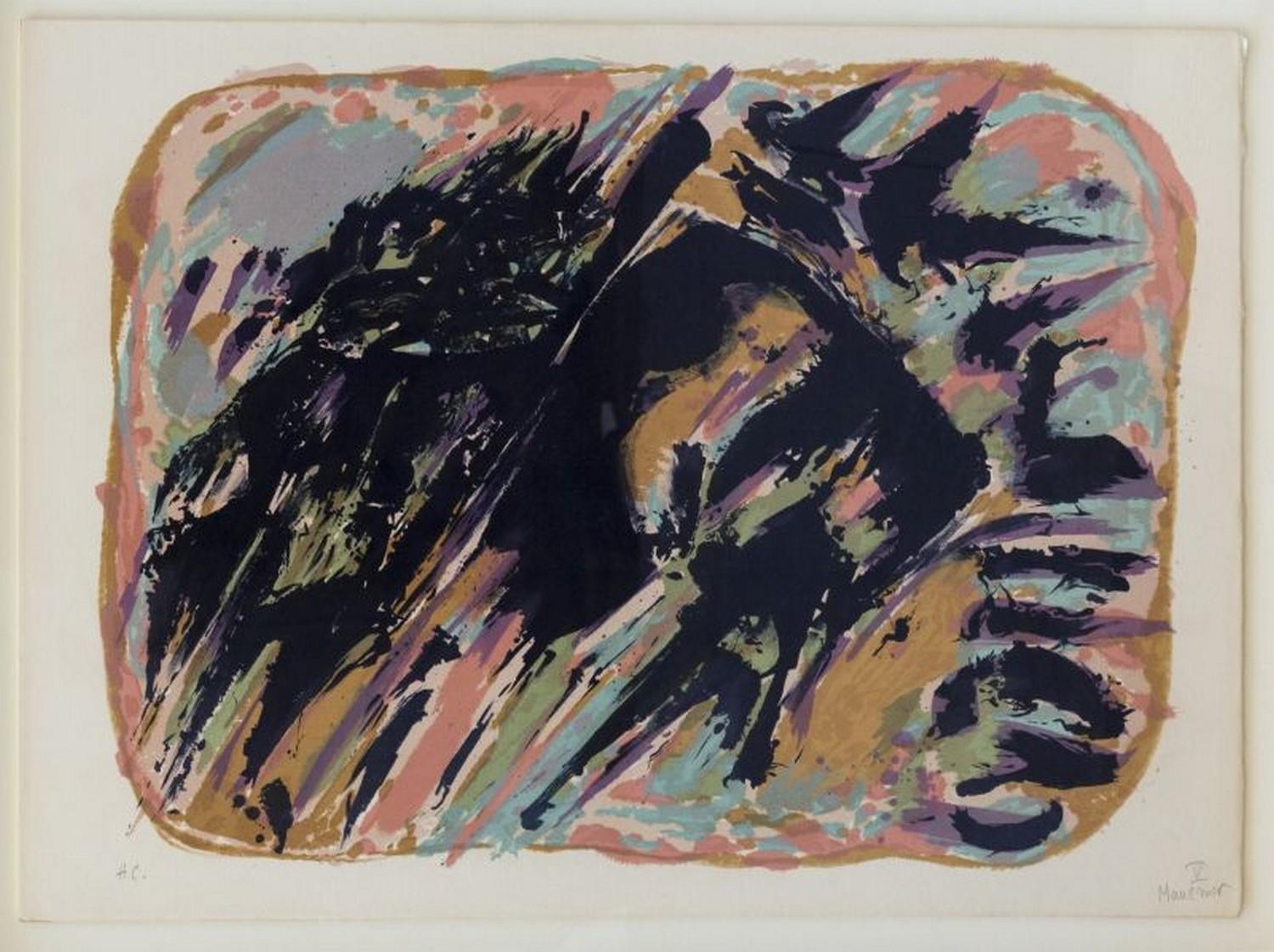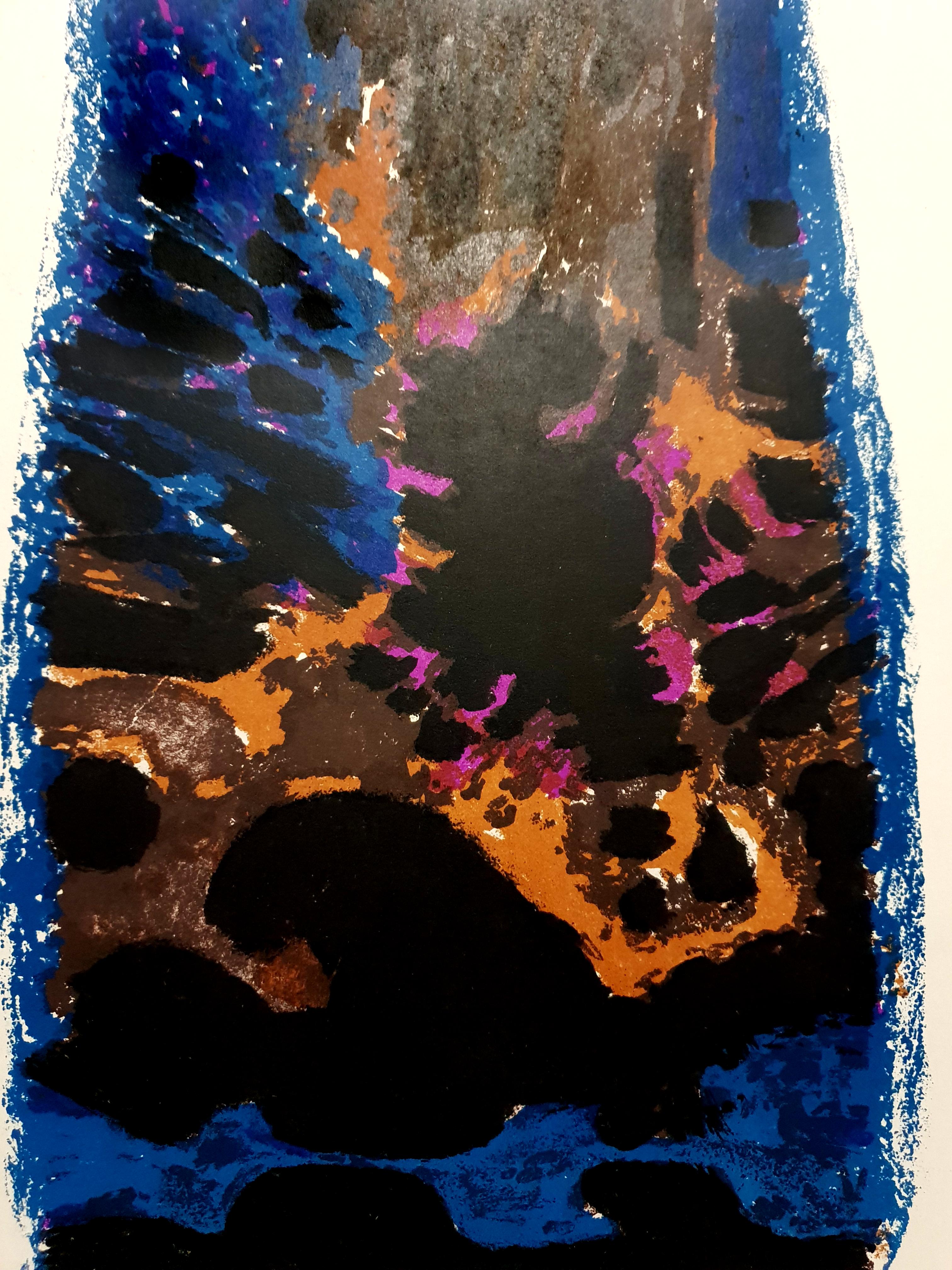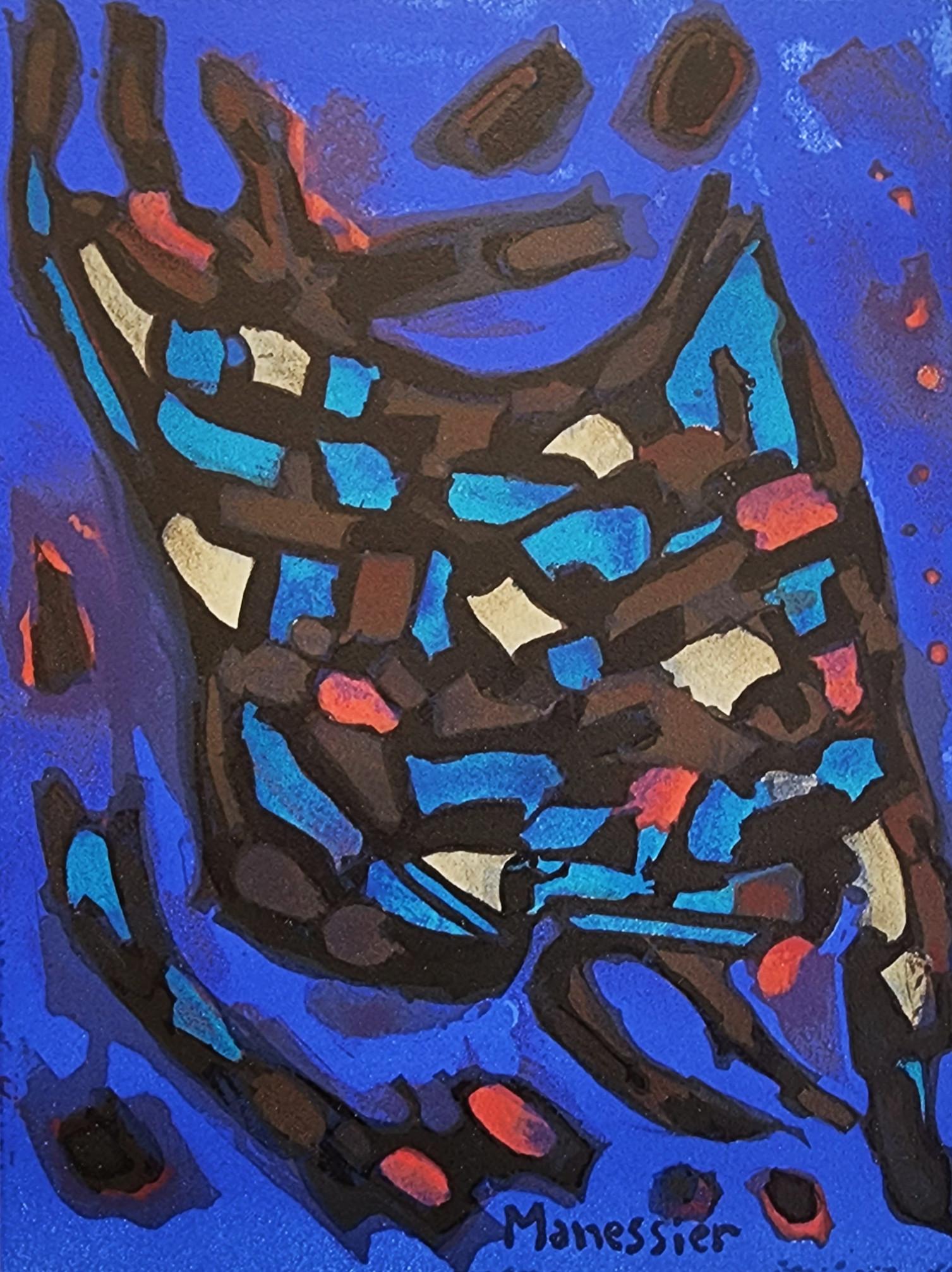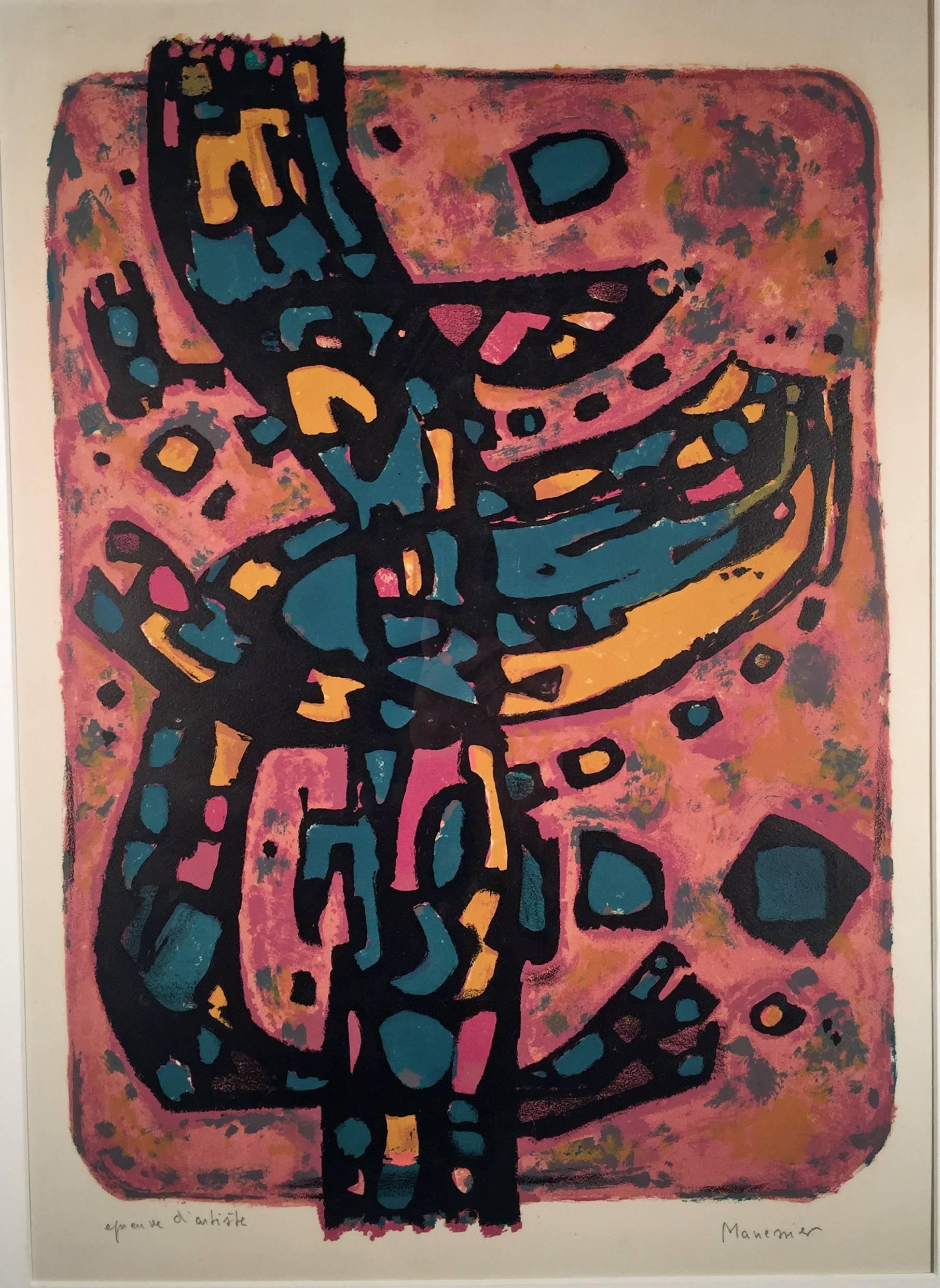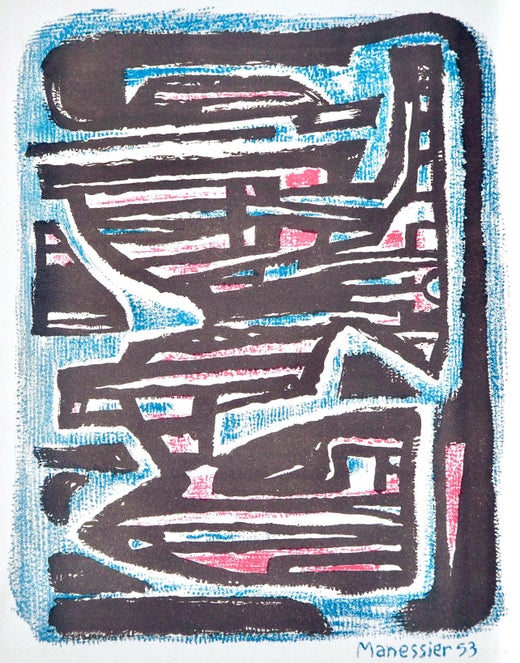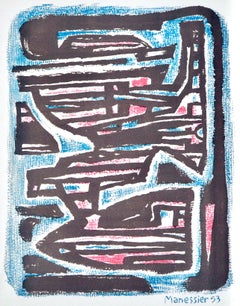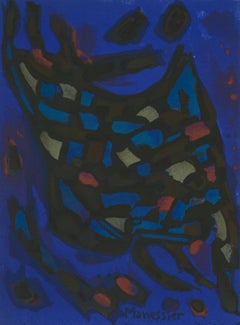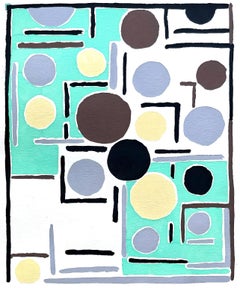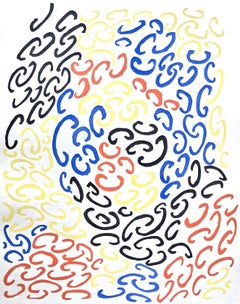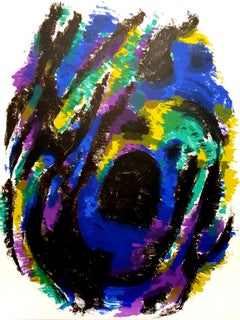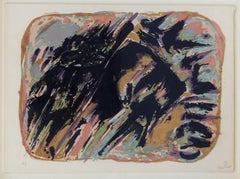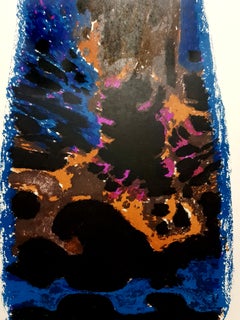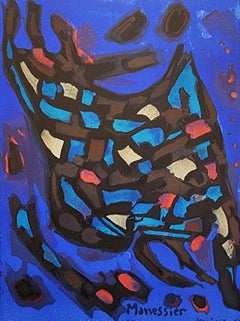Items Similar to Le Nid, Petite tache noire n°1, Société internationale d'art XXe siècle
Want more images or videos?
Request additional images or videos from the seller
1 of 7
Alfred ManessierLe Nid, Petite tache noire n°1, Société internationale d'art XXe siècle1960
1960
$716
$89520% Off
£541.98
£677.4820% Off
€621.65
€777.0720% Off
CA$1,006.42
CA$1,258.0220% Off
A$1,107.55
A$1,384.4420% Off
CHF 580.79
CHF 725.9820% Off
MX$13,441.17
MX$16,801.4720% Off
NOK 7,259.75
NOK 9,074.6820% Off
SEK 6,872.97
SEK 8,591.2120% Off
DKK 4,640.96
DKK 5,801.2120% Off
About the Item
Lithograph on vélin paper. Paper Size: 12.4 x 9.65 inches. Inscription: Unsigned and unnumbered, as issued. Notes: From the album, XXe siècle, Nouvelle série, XXIIe Année, N° 15, Noël 1960, Cahiers d'Art publiés sous la direction de Gualtieri di San Lazzaro, 1960. Published by Société Internationale d'Art XXe siècle, Paris, under the direction of Gualtieri di San Lazzaro, éditeur, Paris; printed by Mourlot Frères, Paris, 1960. Additional notes: Excerpted from the academic article, “Promoting Original Prints, The Role of Gualtieri di San Lazzaro and XXe Siècle” by Valerie Holman, published in Print Quarterly, XXXIII, 2016, 2, Until recently very little has been written on the Italian author and art publisher Gualtieri di San Lazzaro (1904-75), yet for 50 years he chronicled the life and work of contemporary artists, produced monographs of exceptional quality, and disseminated original prints by modern painters and sculptors through his best-known periodical, XXe Siècle. Although still a relatively unfamiliar figure in the United Kingdom, San Lazzaro is one of the half-dozen great art publishers of the mid-twentieth century who, together with his exemplar, Ambroise Vollard (1866-1939), and those of his own generation, Christian Zervos (1889-1970), Tériade (1889-1983) and Albert Skira (1904-73), chose to base himself in Paris, seeing it throughout his life as the centre of the art world….XXe Siècle, an illustrated periodical, was launched in 1938 and printed in editions of approximately 2,000, each issue containing both photographs and four-colour separation reproductions across a wide spectrum of visual imagery ranging from masterpieces of Western painting to popular prints from the Far East. Its large format, lively design, and close integration of text and image, were immediately striking, but its most innovative feature, introduced at the suggestion of Hans Arp (1886-1966), was the inclusion of original prints by contemporary artists in every issue. With obvious appeal for collectors, XXe Siècle was also designed to introduce a wider, international public to contemporary painting and sculpture through good quality colour reproductions and the immediacy of original prints. Comparable in price to Cahiers d'Art, early issues of XXe Siècle sold out rapidly. While San Lazzaro's own aesthetic preferences tended towards lyric abstraction, he made clear that XXe Siècle was non-partisan [publication ceased during World War II]….in 1951, San Lazzaro relaunched XXe Siècle with thematic issues that were materials based, or centred on a topic of current interest in the visual arts, particularly in Europe: concepts of space, matter, monochrome, mark-making and the sign.' A defining feature of the new series was Italy's artistic dialogue with France for, while San Laz-zaro had originally concentrated on Paris-based painters and sculptors, his aim was to create an international network, to make known the work of French artists in Italy and Italian artists in France, and subsequently extend this bilateral axis to the English-speak-ing world. The artists represented in No. I by an original print were all best known as sculptors: Arp, Laurens, Henry Moore (1898-186) and Marino Marini, San Lazzaro not only sought to show readers the full range of an artist's work, but to encourage the production of prints, a stimulus much appreciated, for example, by Magnelli…. Suffering from failing health, in 1968 San Lazzaro lost overall control of XXe Siècle to Léon Amiel, a printer-publisher who had provided financial backing and helped with distribution in America." Thematic issues now ceased and were replaced by a 'panorama' of the year, but San Lazzaro was still active as a publisher of books and albums of prints….Shortly after his death, San Lazzaro himself was the subject of two exhibitions: 'Omaggio a XXe Siècle' in Milan in December 1974 centred on graphic work by those artists closest to him late in life, while 'San Laz-zaro et ses Amis' at the Musée d'Art Moderne de la Ville de Paris in 1975 featured work by all those whose work he had promoted for more than 50 years: Arp, Calder (1898-1976), Capogrossi, Chagall, Sonia Delau-nay, Dubuffet, Estève, Lucio Fontana (1899-1968), Gili-oli (1911-77), Magnelli, Marini, Miró, Moore and Poliakoff. This exhibition was seen by one of his closest colleagues as an indirect portrait of San Lazzaro, a complex man whose modesty and reserve masked his unremitting drive to extend international appreciation of contemporary art, and to bring the reading public closer to its making through the medium of print.
ALFRED MANESSIER (1911-1993) was a non-figurative French painter, stained glass artist, and tapestry designer, part of the new School of Paris and the Salon de Mai. Finding inspiration in the natural surroundings of his native region, Manessier began to paint landscapes at an early age. For his formal education, he studied architecture, first in Amiens and then as an architecture student at the École des beaux-arts, Paris, in 1929. Manessier disliked the school’s formal atmosphere and preferred to copy paintings at the Louvre—particularly those by old masters such as Rembrandt van Rijn, Peter Paul Rubens, and Tintoretto—and frequent the ateliers of Montparnasse. He also briefly studied in 1935 at the Académie Ranson under Roger Bissière, who introduced Manessier to fresco technique, and leading up to World War II, his paintings began to reflect both Cubist and Surrealist influences. In 1939 Manessier was drafted into military service.
In the postwar period, Manessier was associated with Lyrical Abstraction (Abstraction lyrique) and Art Informel. However, his work also adhered to a more specific strand of French art that appeared during the German occupation and incorporated Christian themes and symbolism into semiabstract compositions. The Catholic painter, Jean Bazaine, a strong proponent of art sacré (sacred art), included Manessier’s work in the famous Vingt jeunes peintres de tradition française (Twenty young painters of the French tradition, 1941) organized at Galerie Braun, Paris, in defiance of the Nazis. In 1943, Manessier experienced a religious awakening during a three-day retreat to a Trappist monastery. Soon after he converted to Roman Catholicism and began to pursue an increasingly ascetic lifestyle. In 1945 his compositions started to recall stained-glass windows and turned more abstract, although figurative elements connected to religion and landscape continued to appear. His paintings allude to religious meanings through their titles and through combinations of discernible symbols and abstract imagery.
While Manessier initially gained international recognition for his paintings, he was fluent in a variety of mediums, including lithography, as well as designs for tapestries, liturgical objects, and vestments. At the urging of Georges Rouault, Manessier began to work on stained glass in 1948 and completed many pieces for churches in France, Germany, Spain, and Switzerland. Beginning in 1956, religious symbolism and political themes coexist in a number of works responding to various political events such as the Suez Crisis, invasion of Hungary, and assassination of Martin Luther King Jr. In the 1960s Manessier made several trips to Spain, where he was influenced by the works of El Greco and Francisco de Goya, as well as to Canada, the Netherlands, and the South of France, where the natural landscapes—a persistent theme throughout his oeuvre—influenced the content and style of his work at the time. In 2007, Alfred Manessier‘s painting, Turris Davidica, sold for $593,217 USD at Cornette de Saint Cyr Paris, setting a world record for the artist.
- Creator:Alfred Manessier (1911 - 1993, French)
- Creation Year:1960
- Dimensions:Height: 12.4 in (31.5 cm)Width: 9.65 in (24.52 cm)
- Medium:
- Movement & Style:
- Period:
- Condition:
- Gallery Location:Southampton, NY
- Reference Number:1stDibs: LU1465216495532
Alfred Manessier
Alfred Manessier was born on 5 December 1911 in Saint-Ouen in the Somme. Trained at the Ecole des Beaux-Arts in Amiens (1924 - 1929), he completed his training at the Ecole des Beaux-Arts in Paris and spent a brief period in the studio of the painter Roger Bissière, who introduced him to frescoes and to whom he took refuge in Boissiérettes in the Lot at the beginning of the war. From 1947 onwards, stained glass occupied a large part of his work, which was now based on abstraction. He carried out about twenty projects in France, including the stained glass windows for the church of Saint-Michel des Bréseux (Doubs), his first commission (1948 - 1950), those in the church of Saint-Pierre de Trinquetaille in Arles (1953), and the chapel of Sainte-Thérèse de l'Enfant Jésus et de la Sainte Face in Hem (Nord - 1957). The stained glass windows of the Church of the Holy Sepulchre in Abbeville, one of his last commissions carried out between 1982 and 1993, are considered his masterpiece. He also executed a dozen stained glass projects in Switzerland, Germany and Spain. As an abstract painter of the Ecole de Paris, Manessier frequently tackled subjects related to the Catholic religion. His paintings are often inspired by the landscapes of Northern France, but also by his travels. From 1956 onwards, he produced a large number of political paintings entitled "Hommage", which echoed the violence in the world. The dissemination of his artworks in the public space through these stained glass windows gave him great notoriety during his lifetime, and his paintings were awarded numerous international prizes (such as the Grand Prix of the Venice Biennale, which he received in 1962, alongside Albert Giacometti, who received the Grand Prix for sculpture). He died on 1er August 1993 as a result of a car accident, shortly after the completion of the stained glass windows in Abbeville.
About the Seller
4.9
Platinum Seller
Premium sellers with a 4.7+ rating and 24-hour response times
Established in 1978
1stDibs seller since 2021
1,189 sales on 1stDibs
Typical response time: <1 hour
- ShippingRetrieving quote...Shipping from: Southampton, NY
- Return Policy
Authenticity Guarantee
In the unlikely event there’s an issue with an item’s authenticity, contact us within 1 year for a full refund. DetailsMoney-Back Guarantee
If your item is not as described, is damaged in transit, or does not arrive, contact us within 7 days for a full refund. Details24-Hour Cancellation
You have a 24-hour grace period in which to reconsider your purchase, with no questions asked.Vetted Professional Sellers
Our world-class sellers must adhere to strict standards for service and quality, maintaining the integrity of our listings.Price-Match Guarantee
If you find that a seller listed the same item for a lower price elsewhere, we’ll match it.Trusted Global Delivery
Our best-in-class carrier network provides specialized shipping options worldwide, including custom delivery.More From This Seller
View AllFormes et transparence, Société internationale d'art XXe siècle
By Alfred Manessier
Located in Southampton, NY
Lithograph on vélin paper. Paper Size: 12.4 x 9.65 inches. Inscription: Signed in the plate and unnumbered, as issued. Notes: From the album, XXe siècle, Nouvelle série N°4 (double) ...
Category
1950s Modern Abstract Prints
Materials
Lithograph
$796 Sale Price
20% Off
Free Shipping
Manessier, Composition, Prints from the Mourlot Press (after)
By Alfred Manessier
Located in Southampton, NY
Lithograph on vélin d'Arches paper. Unsigned and unnumbered, as issued. Good condition. Notes: From the album, Prints from the Mourlot Press, 1964. Published by Fernand Mourlot, Par...
Category
1960s Modern Abstract Prints
Materials
Lithograph
$716 Sale Price
40% Off
Free Shipping
Delaunay, Planche No. 15, Compositions, couleurs, idées: Sonia Delaunay (after)
By Sonia Delaunay
Located in Southampton, NY
Colour stencil with dense gouache inks on wove paper. Unsigned and unnumbered with printed title-heading designed by Delaunay, upper left, as issued. Good Condition; never framed or ...
Category
1930s Modern Abstract Prints
Materials
Stencil
$1,436 Sale Price
20% Off
Free Shipping
Delaunay, Planche No. 10, Compositions, couleurs, idées: Sonia Delaunay (after)
By Sonia Delaunay
Located in Southampton, NY
Colour stencil with dense gouache inks on wove paper. Unsigned and unnumbered with printed title-heading designed by Delaunay, upper left, as issued. Good Condition; never framed or ...
Category
1930s Modern Abstract Prints
Materials
Stencil
$1,436 Sale Price
20% Off
Free Shipping
Composition 66 (Abadie 66), Société internationale d'art XXe siècle
By Alberto Magnelli
Located in Southampton, NY
Linocut on vélin paper. Paper Size: 12.4 x 9.65 inches. Inscription: Unsigned and unnumbered, as issued. Catalogue raisonné references: Magnelli, Alberto, and Daniel Abadie. Magnelli...
Category
1930s Modern Abstract Prints
Materials
Linocut
$716 Sale Price
20% Off
Free Shipping
Delaunay, Planche No. 33, Compositions, couleurs, idées: Sonia Delaunay (after)
By Sonia Delaunay
Located in Southampton, NY
Colour stencil with dense gouache inks on wove paper. Unsigned and unnumbered with printed title-heading designed by Delaunay, upper left, as issued. Good Condition; never framed or ...
Category
1930s Modern Abstract Prints
Materials
Stencil
$1,436 Sale Price
20% Off
Free Shipping
You May Also Like
Alfred Manessier - Original Lithograph
By Alfred Manessier
Located in Collonge Bellerive, Geneve, CH
Alfred Manessier - Original Lithograph
Colorful Abstraction
1962
From XXe Siecle
Dimensions: 32 x 24
Edition: G. di San Lazzaro.
Unsigned and unumbered as issued
Category
1960s Modern Figurative Prints
Materials
Lithograph
Composition abstraite
By Alfred Manessier
Located in Paris, FR
Lithograph, 1975
Edition : V/XV
56.00 cm. x 76.00 cm. 22.05 in. x 29.92 in. (paper)
50.00 cm. x 67.00 cm. 19.69 in. x 26.38 in. (image)
Lithograph belonging to a series of 15 litho...
Category
1970s Abstract Abstract Prints
Materials
Lithograph
Alfred Manessier - Lithograph
By Alfred Manessier
Located in Collonge Bellerive, Geneve, CH
Alfred Manessier - Lithograph
1962
From the art periodical XXe Siecle (no. 20)
Dimensions: 32 x 24
Edition: G. di San Lazzaro.
Unsigned and unnumbered as issued
Category
1960s Modern Figurative Prints
Materials
Lithograph
Composition (Mourlot, Paris)
By Alfred Manessier
Located in Kansas City, MO
Alfred Manessier
Composition
1964
Original Color Lithograph on Velin d'Arches
Size: 10x7.375in
Edition: 2,000
Signed in the Stone
Annotated verso
Publisher: Mourlot, Paris
Printer: M...
Category
1960s Modern Prints and Multiples
Materials
Vellum, Lithograph
Price Upon Request
FLAMME VIVE
By Alfred Manessier
Located in Portland, ME
Manessier, Alfred. FLAMME VIVE. Lithograph in colors, 1959. Artist's Proof in addition to the edition of 175. Inscribed "Epreuve d'Artiste" and signed in pencil. 20 x 13 1/2 inches, ...
Category
Mid-20th Century Abstract Abstract Prints
Materials
Lithograph
$700 Sale Price
20% Off
Laudes II
By Alfred Manessier
Located in Paris, FR
Lithograph, 1976
Handsigned by the artist in pencil
Artist proof
Printer : Mourlot, Paris
65.50 cm. x 60.50 cm. 25.79 in. x 23.82 in. (paper)
57.00 cm. x 49.00 cm. 22.44 in. x 1...
Category
1970s Abstract Abstract Prints
Materials
Lithograph
